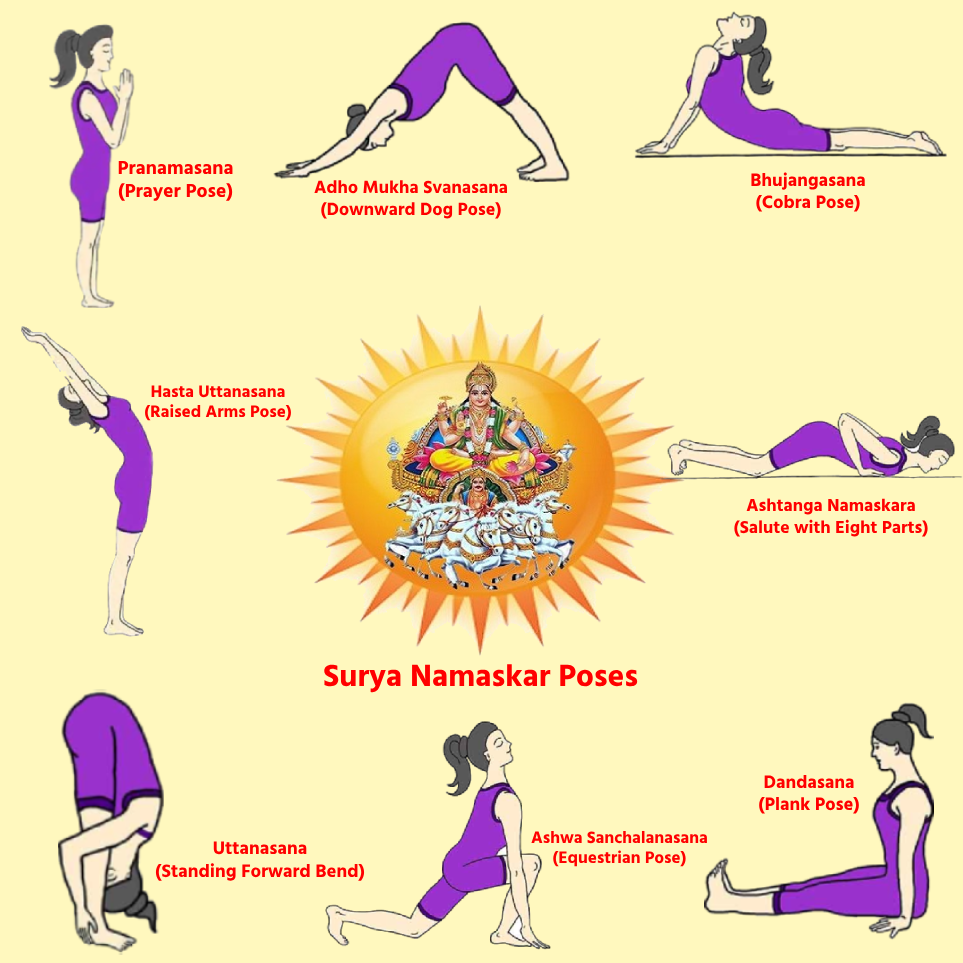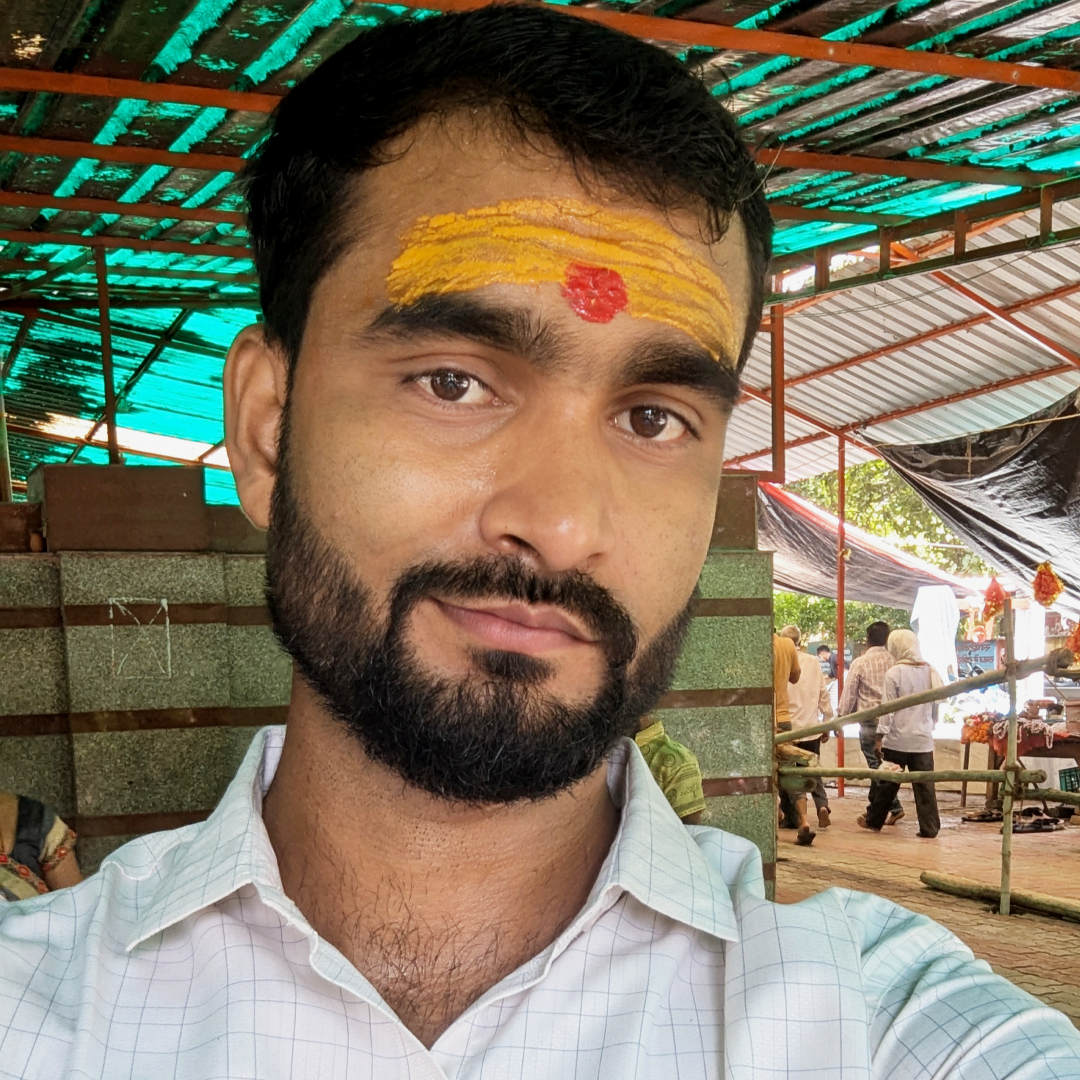When it comes to an exercise that energizes the body, mind, and soul together, the first name that comes to mind is Surya Namaskar Exercise. It is not just an ordinary exercise but a miraculous gift from the Indian yoga tradition. It not only transforms the body but also changes the lifestyle. Let us explain it to you in detail—
What is Surya Namaskar Exercise
Surya Namaskar, which literally means “Salutation to the Sun,” is a special yoga practice that combines 12 yoga poses in a specific sequence. This practice is done to honor the energy of the sun and energize the body. Each pose has its own scientific and spiritual significance.
The Surya Namaskar 12 Step Name, Their Mantras, and Benefits

| Se. No. | Name Of Asan | Mantra | Benefit |
|---|---|---|---|
| 1. | Pranamasana (Namaste Pose) | Om Mitraya Namah | Enhances mental focus and calms the mind. |
| 2. | Hast Uttanasana (Raised Arms Pose) | Om Ravaye Namah | Increases spinal flexibility and strengthens the lungs. |
| 3. | Padahastasana (Hand to Foot Pose) | Om Suryaya Namah | Activates the digestive system and reduces belly fat. |
| 4. | Ashwa Sanchalanasana (Equestrian Pose) | Om Bhanave Namah | Strengthens thighs and legs, develops balance. |
| 5. | Dandasana (Stick Pose) | Om Khagaya Namah | Builds overall body strength and endurance. |
| 6. | Ashtanga Namaskara (Eight Point Salute) | Om Pushne Namah | Strengthens the heart and improves blood circulation. |
| 7. | Bhujangasana (Cobra Pose) | Om Hiranyagarbhaya Namah | Improves spinal flexibility and enhances lung capacity. |
| 8. | Parvatasana (Mountain Pose) | Om Marichaye Namah | Tones the body and reduces stress. |
| 9. | Ashwa Sanchalanasana (other leg) | Om Adityaya Namah | Develops body balance and power. |
| 10. | Padahastasana | Om Savitre Namah | Stretches the back and hamstrings, improves digestion. |
| 11. | Hast Uttanasana | Om Arkaya Namah | Opens the lungs and energizes the body. |
| 12. | Pranamasana | Om Bhagay Namah | Concludes the practice and awakens a sense of gratitude. |
Surya Namaskar is not just a physical workout but a lifestyle. It connects us with nature, balances the soul, and strengthens us from within. If you chant the Surya Namaskar mantra along with it, its effect multiplies manifold.
Surya Namaskar Exercise Steps – A Simple Guide
The 12 steps of Surya Namaskar are detailed as follows:
Step 1: Pranamasana (Prayer Pose)
Begin your yoga journey with deep respect and dedication. Stand straight at the edge of your mat, keep your feet together, and balance your weight equally on both feet.
Expand your chest, relax your shoulders. As you inhale, raise both hands up, and as you exhale, bring them together in front of your chest – as if your soul is greeting the Sun.
Step 2: Hastauttanasana (Raised Arms Pose)
Slowly inhale and lift your arms up and back, keeping your biceps close to your ears.
This pose stretches the whole body from heels to fingertips – as if you are lifting yourself towards the light.
To deepen the stretch, gently push your pelvis forward and try to reach the sky with your fingers without forcing your back to bend.
Step 3: Hastapadasana (Standing Forward Bend)
Exhale and bend forward from your waist keeping your spine straight. As you completely exhale, place both hands on the floor beside your feet.
If your hands do not reach the floor, you may bend your knees slightly. Then gradually try to straighten the knees. Keep your hands fixed in this position as it brings stability in the following poses.
Step 4: Ashwa Sanchalanasana (Equestrian Pose)
Inhale and take your right leg back as far as possible. Place your right knee on the floor and look upward – as if gazing at the Sun.
Important point:
Your left foot should be exactly between your palms to maintain balance.
Step 5: Dandasana (Stick Pose)
Now inhale and take your left leg back as well, forming a straight line with your whole body – like a strong stick from head to heels.
For better posture:
Keep your arms straight on the ground, so your elbows are perpendicular to the floor.
Step 6: Ashtanga Namaskara (Eight-Limbed Salute)
Slowly bring both knees to the floor and exhale. Move your hips back slightly and slide forward to rest your chest and chin on the floor.
In this pose, eight parts of the body – two hands, two feet, two knees, chest, and chin – touch the floor.
This is a complete surrender pose – as if the soul, body, and mind all bow down to the Sun’s feet.
Step 7: Bhujangasana (Cobra Pose)
Slowly slide your body forward and raise your chest. Keep your elbows slightly bent and shoulders away from the ears. Look straight up – as if filling yourself with confidence and energy.
To deepen the stretch Inhale and gently push your chest forward; exhale and push your navel towards the floor. Curl your toes under but do not force your body – stretch only as comfortably as possible.
Step 8: Adho Mukha Svanasana (Downward Facing Dog Pose)
Exhale and lift your hips and spine up, forming an inverted ‘V’ shape with your body. This pose flows energy and stretches the entire body.
If possible, keep your heels on the ground and lift your tailbone higher. This will deepen the stretch gradually.
Step 9: Ashwa Sanchalanasana (Equestrian Pose)
Inhale and bring your right foot forward between your hands. Place your left knee on the floor. Press your hips down and look upward – as if connecting to the earth and opening to the sky.
Keep your right foot straight so your calf is perpendicular to the floor. Slowly press your hips down to deepen the stretch.
Step 10: Hastapadasana (Standing Forward Bend)
Exhale and bring your left foot forward as well, keeping both feet together and palms on the floor. Bend your knees slightly if needed.
To deepen the stretch, gradually straighten your knees and try to touch your nose to your knees. Keep breathing calmly.
Step 11: Hastauttanasana (Raised Arms Pose)
Inhale and slowly roll your spine up. Raise your hands and gently bend backward, pushing your hips slightly outward – as if embracing the first rays of the morning sun.
Make sure your biceps stay close to your ears. Focus on stretching upwards more than bending backward.
Step 12: Tadasana (Mountain Pose)
Exhale and slowly straighten your body, lowering your arms down. Close your eyes and pause for a moment to feel the energy flowing through your body.
This completes one set of Surya Namaskar. A full round is completed when you repeat the sequence starting with the left leg behind in step 4 and bringing the left foot forward in step 9. Doing this on both sides completes one full round.
How and When to Practice Surya Namaskar Exercise?
Learn the best time and proper way to practice Surya Namaskar yoga and make it a powerful part of your daily routine.
- Time: Practicing Surya Namaskar early in the morning, with the first rays of the sun, is the most beneficial. At this time, the environment is calm and full of energy.
- Location: Choose a place where you can breathe freely — like a terrace, garden, or near a window. If practicing indoors, the room should be well-ventilated and peaceful.
- Empty Stomach: Surya Namaskar should always be done on an empty or light stomach. If you have eaten something, wait at least 2.5 to 3 hours before practicing. This is because digestion and yoga practices cannot function properly together, which may have adverse effects on the body.
- Starting Point: For beginners, 5 rounds per day are sufficient. Gradually, as the body gains flexibility and endurance, you can increase it to 12 rounds or more.
Start your Surya Namaskar practice today and experience a healthier body, a peaceful mind, and a balanced spirit.
Benefits of Surya Namaskar
- Helps maintain cardiovascular health
- Stimulates the nervous system
- Helps in stretching, flexing, and toning the muscles
- An excellent exercise for weight loss management
- Strengthens the immune system
- Enhances cognitive functions
- Improves overall health, strengthens the body, and relaxes the mind
Precautions
- Consult a doctor if you have back pain, high blood pressure, or are pregnant.
- Maintain coordination with your breath rather than doing the movements quickly.
- Keep steadiness and calmness in every posture.
FAQ
Should it be done daily?
Yes, doing 12 rounds of Surya Namaskar daily is considered ideal, especially in the morning.
Are mantras necessary in it?
Mantras are not mandatory, but if you practice with the mantra “Om Suryaya Namah,” it adds a spiritual effect.
Does Surya Namaskar help in weight loss?
Yes, it is a combination of cardio and stretching that helps reduce body fat.
Can women do it?
Yes, women can also do it. However, they should take care during pregnancy and menstruation.
Can children do it?
Absolutely, but initially, they should practice under the supervision of a trainer.

मैं पंडित सत्य प्रकाश, सनातन धर्म का एक समर्पित साधक और श्री राम, लक्ष्मण जी, माता सीता और माँ सरस्वती की भक्ति में लीन एक सेवक हूँ। मेरा उद्देश्य इन दिव्य शक्तियों की महिमा को जन-जन तक पहुँचाना और भक्तों को उनके आशीर्वाद से जोड़ना है। मैं अपने लेखों के माध्यम से इन महान विभूतियों की कथाएँ, आरती, मंत्र, स्तोत्र और पूजन विधि को सरल भाषा में प्रस्तुत करता हूँ, ताकि हर भक्त अपने जीवन में इनकी कृपा का अनुभव कर सके।जय श्री राम View Profile